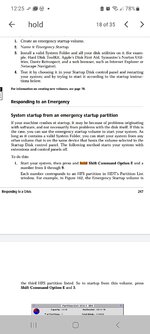Please read this old post:
Setting startup disk on LC475. Unfortunately, some references to even older posts are lost. Also, currently (2023-11-12) the Wiki appears not to be available.
However, to use any drive, it has to be formatted properly to be operational on the intended host computer. Each time the computer is started, the driver for every SCSI drive has to be loaded. If no removable storage media is present in a drive at the time of startup, by default the system would not load a driver for that drive. Thus, some driver software suites include system extensions that will pre-load the necessary driver anyway. The iomega tools and also FWB Hard Disk Toolkit come with such extensions, that are to be installed in the System Folder. The extensions let the removable media mount also if it is inserted after the boot process. If such extension is not available, the drive should still work fine as long as a properly formatted media is inserted upon startup.
To select from different drives upon startup, one may use the key combo Command-Shift-Option-Delete. It might be that this will not work on every Mac. The key combo switches from the startup disk that is specified in PRAM to the next available one (just counting along the SCSI IDs). Only drives with a properly »blessed« System Folder will be available.
If the computer has a drive with multiple volumes (partitions), which you can set up using the FWB Hard Disk Toolkit, you can install or just copy and bless a bootable System Folder onto each of that volumes. Probably the Control Panel »Startup Disk« will even allow to specify one of those partitions as a Startup Disk. If you want to arbitrarily select the desired volume upon startup, you need help from HDT. Properly installed, it makes a set of key combos available. It is something like cmd-opt-shift in combination with the desired partition number on the specified drive. For example, the Mac is set up to boot from SCSI ID 2 and upon startup the key combo cmd-opt-shift-5 is depressed, than the Mac will use the fifth partion on the disk present at SCSI ID 2, as long as there is a blessed System Folder present on that volume.
If you have use for this feature, please obtain a copy of FWB HDT in the most recent version that runs on your Mac, and refer to the manual. I always use the manual as a valuable ressource to learn what to expect from a software. So, besides how to format a beer mat, I learned about other interesting features of HDT. For example, every HDT formatted disk can be password protected. Please note, that HDT password protection can easily be bypassed in the early revisions of this software.
By the way: Some 68k Macs do run properly up to version Mac OS 8.1, which supports also HFS+ instead of only HFS formatted volumes. Unfortunately, there is no (known to me) way of booting a 68k Mac from an HFS+ formatted volume. I tried this in many configurations with a maxed out Performa 630, to make better use of a giant harddisk. Whilst that machine can _mount_ HFS+ volumes _after_ startup with 8.1, it will never boot from a HFS+ formatted disk. Any of my related attempts to mix volumes with different file systems on the same harddisk were not successful on that machine, also.
→ If you succeed in putting rare features into good use, please share your insight



